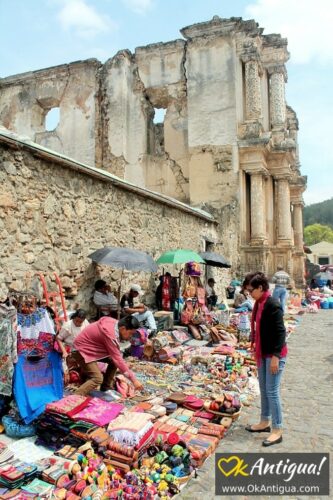

In 1523, just two years after the Aztec capital of Tenochitlan fell to Hernán Cortés and his Conquistadors, the first Roman Catholic missionaries arrived to begin the religious conquest of Mexico.

Fray Bernadino de Sahagún and his fellow Franciscan brothers immediately immersed themselves in the intensive study of indigenous tongues along with the history, customs and religious practices of the Mexicas, whom they called Aztecs. Soon fluent in Nahuatl, they proceded to translate religious texts and teach the Christian doctrines.
Among their first converts was a man baptized with the Christian name Juan Diego. On the chilly morning of December 9, 1531, Juan Diego crossed the barren hill called Tepeyac to attend Mass. He was brought to a sudden halt by a blinding light and the sound of unearthly music. Before him appeared an astounding vision--a beautiful dark-skinned woman who, calling the Indian "my son," declared herself to be the Virgin Mary, the mother of Jesus Christ. She told Juan Diego it was her desire to have a church built on Tepeyac hill, and asked him to relay that message to Bishop Juan de Zumarraga.
 It was no easy task for the humble Indian to be granted an audience with the top prelate, but the persistent Juan Diego was finally admitted. The incredulous Bishop demanded that he be provided with some proof of the unlikely encounter. Confused and fearful, Juan Diego avoided Tepeyac for several days, but on December 12, while rushing to find a priest to attend a seriously ill uncle, he took a short cut across the hill. The Virgin once again appeared and Juan Diego told her of the Bishop's request. The Virgin instructed him to pick roses from the usually serene and desolate hill and deliver them to Zumarraga as the sign.
It was no easy task for the humble Indian to be granted an audience with the top prelate, but the persistent Juan Diego was finally admitted. The incredulous Bishop demanded that he be provided with some proof of the unlikely encounter. Confused and fearful, Juan Diego avoided Tepeyac for several days, but on December 12, while rushing to find a priest to attend a seriously ill uncle, he took a short cut across the hill. The Virgin once again appeared and Juan Diego told her of the Bishop's request. The Virgin instructed him to pick roses from the usually serene and desolate hill and deliver them to Zumarraga as the sign.
Juan Diego gathered up the miraculous blossoms in his mantle and hurried off to complete his mission. Once again before the Bishop, he let the roses spill out before him. To the wonder of all assembled, a perfect image of La Virgen Morena (the Dark Virgin) was revealed emblazoned on Juan Diego's cloak.

By order of the Bishop, a small church was soon constructed on the site designated by the Virgin. Skeptics are quick to point out the unlikely coincidence of the Virgin's appearance on Tepeyac, the very site of an Aztec temple dedicated to Tonatzin (earth godess, mother of the gods and protectress of humanity) which had been devastated by order of Bishop Zumarraga.
The original church was replaced by a larger structure built in 1709. The Miracle of Guadalupe was officially recognized by the Vatican in 1745. The second sanctuary was declared a Basilica in 1904, but by then it had begun to slowly sink into the soft, sandy soil beneath it. A new Basilica, of modern design and enormous capacity, was dedicated in October of 1976.

In this and other churches dedicated to La Virgen de Guadalupe throughout the nation, millions of the faithful will gather December 12 for processions, prayers, songs, dances, and fireworks to honor "La Reina de México" (the Queen of Mexico).

Juan Diego's mantle, carefully preserved in the new Basilica, has been subjected to extensive analysis over the years. Experts have authenticated the fabric as dating to the 16th century, but have been unable to determine the type of pigment from which the image was rendered. It seems doubtful that in the Colonial era in Mexico human hands were capable of creating a portrait of its exquisite nature. Most wonderous of all, after 465 years, the image of the Virgen de Guadalupe remains clearly imprinted on the miraculous cloak without visible signs of deterioration.¨


A child in Guatemala City, Guatemala is specially dressed as Juan Diego for celebrating the anniversary of The Virgin of Guadalupe. La Virgen de Guadalupe is honored throughout Latin America on December 12th.
Mexico Connect, read it all, click here
Thanks to Dale Hoyt Palfrey
Thanks to Flickr Photosharing
Thanks to Juan Diego
Thanks to Fray Bernadino de Sahagún
Thanks to Bishop Juan de Zumarraga, First Bishop of Mexico and ¨Protector of the Indians¨

























_-_James_Tissot_-_overall.jpg)















4 comments:
A most beautiful Legend!
And telling of the Gospel, of the Kingdom, of God's own Creation: a despised Human being, a dark hued Virgin, Roses where there were stones
Oh how I love love love this.
I love Juan Diego, I love OL Guadelupe!
So much history I don't know: thank you.
Hi Leonardo--Beautiful post on Our Lady of Guadalupe.
And, couple of days late here (sorry) but HAPPY BIRTHDAY! God is good.
Post a Comment